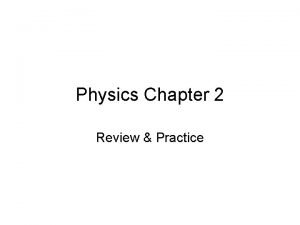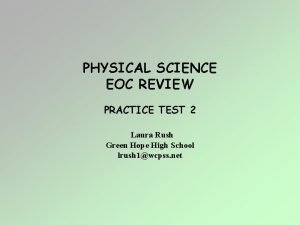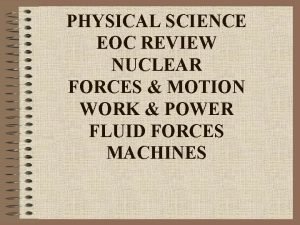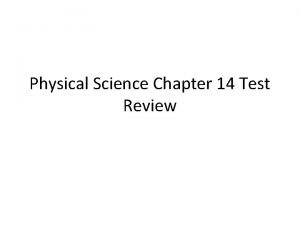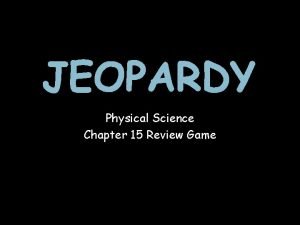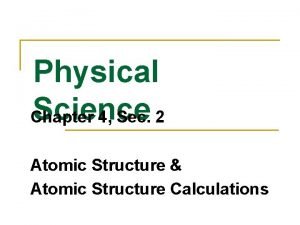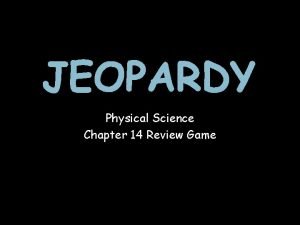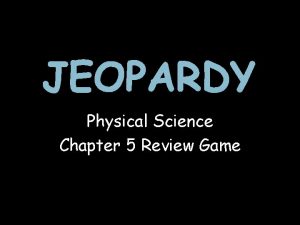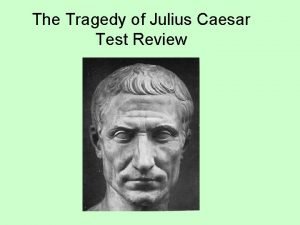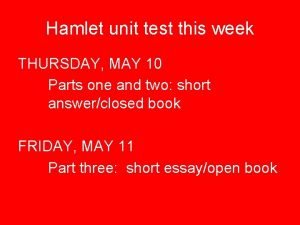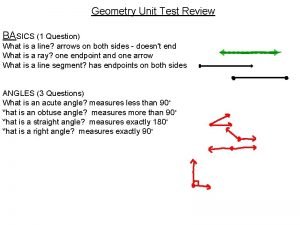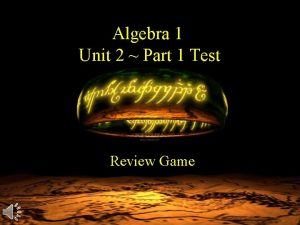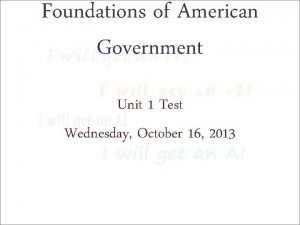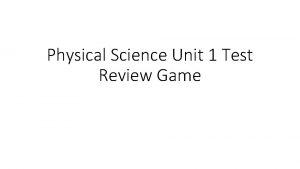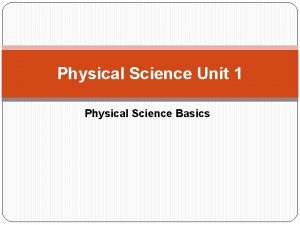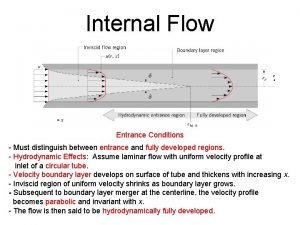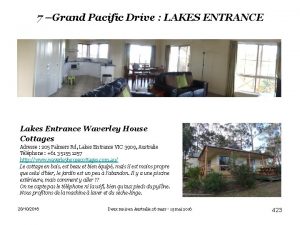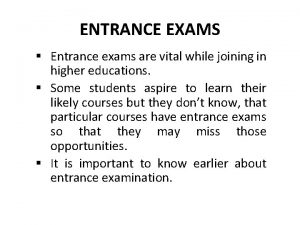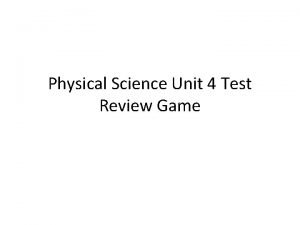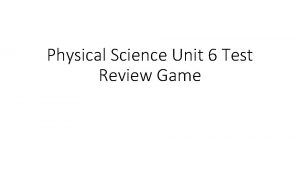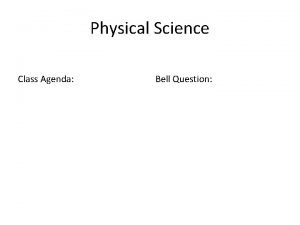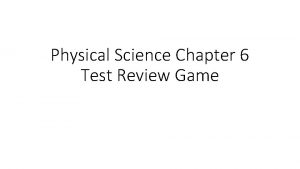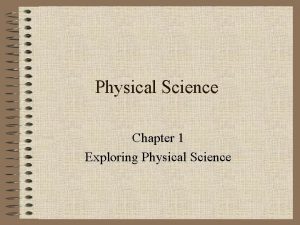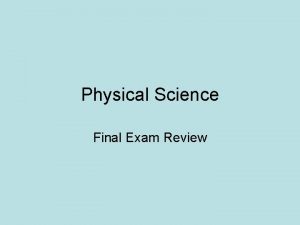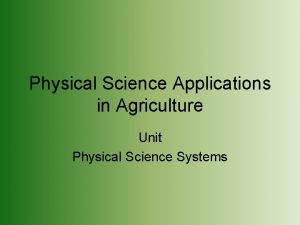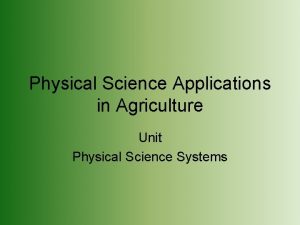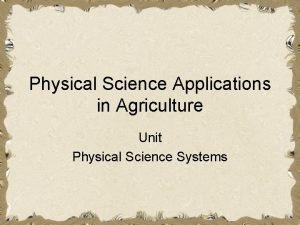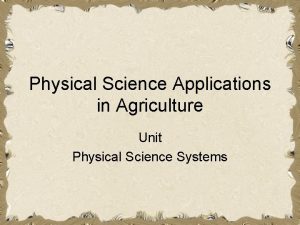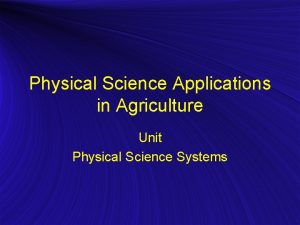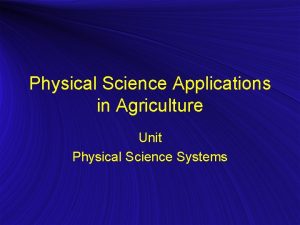Entrance Question Physical Science Unit Test Review On






























- Slides: 30

Entrance Question

Physical Science Unit Test Review

On the test… I can recognize that all matter is made up of atoms. I can explain that atoms take up space, have mass, and are in constant motion. I can describe the composition of substances in terms of elements and/or compounds. I can explain the differences in elements, compounds, and mixtures. I can compare and contrast heat, temperature, and thermal energy. I can explain thermal energy’s effects on a substance. I can investigate temperature change in order to infer changes in thermal energy.

On the test… I can describe the particles of a solid, liquid, and gas (motion and spacing). I can model and explain how mass is conserved when a substance undergo a change in state. I can identify, explain, and model kinetic and potential energy of various objects. I can calculate an object’s speed. I can identify, explain, and model various forms of speed (constant, average, and instantaneous). I can analyze and interpret position vs. time and speed vs. time graphs.

On the test… I can recognize that all matter is made up of atoms. I can explain that atoms take up space, have mass, and are in constant motion. I can describe the composition of substances in terms of elements and/or compounds. I can explain the differences in elements, compounds, and mixtures. I can compare and contrast heat, temperature, and thermal energy. I can explain thermal energy’s effects on a substance. I can investigate temperature change in order to infer changes in thermal energy.

Matter takes up space and has mass Matter is anything that ___________________. mixture pure Matter is either a _____ substance or a __________. An example of matter is __________________. A non-example of matter is _________________.

Table Sugar (C 12 H 22 O 11) What is it? (pure substance or mixture) Be more specific… (element, compound, or mixture) What element(s) does it contain?

Salt (Na. Cl) What is it? (pure substance or mixture) Be more specific… (element, compound, or mixture) What element(s) does it contain?

Elements atom An element is one type of __________. identical Atoms of the same element are ___________. One atom of each element contains a specific number of: protons _________ (+) neutrons _________ (0) electrons _________ (-)

Elements: Boron (B) Protons: + Neutrons: Electrons: -

Elements: Beryllium (Be) Protons: + Neutrons: Electrons: -

On the test… I can recognize that all matter is made up of atoms. I can explain that atoms take up space, have mass, and are in constant motion. I can describe the composition of substances in terms of elements and/or compounds. I can explain the differences in elements, compounds, and mixtures. I can compare and contrast heat, temperature, and thermal energy. I can explain thermal energy’s effects on a substance. I can investigate temperature change in order to infer changes in thermal energy.

Heat, Temperature, & Thermal Energy What is the difference? Match: A The total kinetic energy of the particles in a substance. _____ C The measurement of average kinetic energy of particles. _____ B The transfer of thermal energy from matter that is warm to cold. _____ A. Thermal Energy B. Heat C. Temperature

Heat, Temperature, & Thermal Energy gains As an object _______ thermal energy, its particles move farther apart. loses As an object _______ thermal energy, its particles move slower. gains As an object _______ thermal energy, its particles move faster. loses As an object _______ thermal energy, its particles move closer together.

On the test… I can describe the particles of a solid, liquid, and gas (motion and spacing). I can model and explain how mass is conserved when a substance undergo a change in state. I can identify, explain, and model kinetic and potential energy of various objects. I can calculate an object’s speed. I can identify, explain, and model various forms of speed (constant, average, and instantaneous). I can analyze and interpret position vs. time and speed vs. time graphs.

States of Matter What is the difference? Match: C Definite shape; definite volume _____ B No definite shape; no definite volume _____ A No definite shape; definite volume _____ A. Liquid B. Gas C. Solid

On the test… I can describe the particles of a solid, liquid, and gas (motion and spacing). I can model and explain how mass is conserved when a substance undergo a change in state. I can identify, explain, and model kinetic and potential energy of various objects. I can calculate an object’s speed. I can identify, explain, and model various forms of speed (constant, average, and instantaneous). I can analyze and interpret position vs. time and speed vs. time graphs.

Conservation of Mass The law of conservation of mass says that matter is neither created destroyed ______ nor ________. Two hydrogen molecules are combined with an oxygen molecule. As a result, we get two water molecules. How is this example related to conservation of mass? 2 H 2 + 02 2 H 20

On the test… I can describe the particles of a solid, liquid, and gas (motion and spacing). I can model and explain how mass is conserved when a substance undergo a change in state. I can identify, explain, and model kinetic and potential energy of various objects. I can calculate an object’s speed. I can identify, explain, and model various forms of speed (constant, average, and instantaneous). I can analyze and interpret position vs. time and speed vs. time graphs.

Kinetic and Potential Energy Summarize our egg drop experiment. What did it prove?

Kinetic and Potential Energy A/D Highest Potential: A Highest Kinetic: C Lowest Potential: B Lowest Kinetic: D *** Some boxes may be filled with more than one letter or no letter at all. B/C

On the test… I can describe the particles of a solid, liquid, and gas (motion and spacing). I can model and explain how mass is conserved when a substance undergo a change in state. I can identify, explain, and model kinetic and potential energy of various objects. I can calculate an object’s speed. I can identify, explain, and model various forms of speed (constant, average, and instantaneous). I can analyze and interpret position vs. time and speed vs. time graphs.

Speed A vehicle carrying 4 passengers travels 2, 408 meters. The vehicle gets stopped at 6 red lights while driving this distance. The vehicle’s total driving time was 7 minutes. What was the vehicle’s average speed? Constant Speed vs. Average Speed

Speed Which of the following best demonstrates constant speed? (Select all that apply. ) A) A race car beginning a race B) A roller coaster C) A car on cruise control D) A runner in a marathon

On the test… I can describe the particles of a solid, liquid, and gas (motion and spacing). I can model and explain how mass is conserved when a substance undergo a change in state. I can identify, explain, and model kinetic and potential energy of various objects. I can calculate an object’s speed. I can identify, explain, and model various forms of speed (constant, average, and instantaneous). I can analyze and interpret position vs. time and speed vs. time graphs.

Position vs. Time Graphs Describe the behavior of the object in the graph below. 9 8 7 Distance from school (miles) 6 5 4 3 2 1 1 2 3 4 5 6 7 Time (min) 8 9 10

Position vs. Time Graphs Describe the behavior of the object in the graph below. 9 8 7 Distance from school (miles) 6 5 4 3 2 1 1 2 3 4 5 6 7 Time (min) 8 9 10

Position vs. Time Graphs Describe the behavior of the object in the graph below. 9 8 7 Distance from school (miles) 6 5 4 3 2 1 1 2 3 4 5 6 7 Time (min) 8 9 10

Position vs. Time Graphs Describe the behavior of the object in the graph below. 9 8 7 Distance from school (miles) 6 5 4 3 2 1 1 2 3 4 5 6 7 Time (min) 8 9 10

Position vs. Time Graphs Describe the behavior of the object in the graph below. 9 8 7 Distance from school (miles) 6 5 4 3 2 1 1 2 3 4 5 6 7 Time (min) 8 9 10
 Unit 10, unit 10 review tests, unit 10 general test
Unit 10, unit 10 review tests, unit 10 general test Algebra 2 unit 1 test answers
Algebra 2 unit 1 test answers Costas question levels
Costas question levels Physrt
Physrt Physical science eoc review
Physical science eoc review Physical science eoc review
Physical science eoc review Chapter 4 section 1 work and machines answer key
Chapter 4 section 1 work and machines answer key Physical science chapter 14 review
Physical science chapter 14 review Physical science jeopardy
Physical science jeopardy Physical science chapter 4 review
Physical science chapter 4 review Chapter 14 review physical science
Chapter 14 review physical science Noah carried a skateboard
Noah carried a skateboard Chapter 5 review physical science
Chapter 5 review physical science Physical science chapter 6 review answers
Physical science chapter 6 review answers Chapter 16 review physical science
Chapter 16 review physical science Mind map branches of science
Mind map branches of science Natural science vs physical science
Natural science vs physical science My favourite subject worksheet
My favourite subject worksheet Forensic science unit 1 review
Forensic science unit 1 review Julius caesar test review
Julius caesar test review The tragedy of hamlet unit test
The tragedy of hamlet unit test Geometry unit test
Geometry unit test Algebra 1 unit 2 practice test
Algebra 1 unit 2 practice test John proctor criticizes reverend parris for:
John proctor criticizes reverend parris for: Unit 1 test review us history
Unit 1 test review us history Foundations of american government unit 1 test review
Foundations of american government unit 1 test review Format asl
Format asl Romeo and juliet short answer test questions
Romeo and juliet short answer test questions Unit 6 test review algebra 1
Unit 6 test review algebra 1 Which of the following adaptations helps birds fly?
Which of the following adaptations helps birds fly? Module 5 topic 3 drivers ed
Module 5 topic 3 drivers ed



